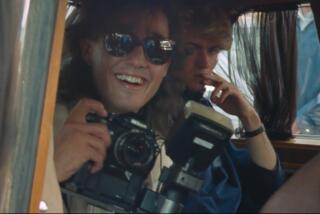A Rude Awakening
- Share via
If you look on Page 2,895 of the New Shorter Oxford English Dictionary, you’ll find the word “sleeper.” If films like “The Truman Show” are any portent for the future, dictionaries--not theaters--will soon be the only places where sleepers can be found.
The dictionary defines sleeper as “a thing which turns out to be an unexpected success.” In times past, the intelligent, surprising “The Truman Show,” the year’s best studio film, would have been a prime candidate for that label and its trajectory would have unfolded in a familiar manner.
The first word the public would have had that an unexpected film (like “Babe” or “The Crying Game” before it) was in fact something special would have been the reviews that came out on opening day or just before it. Audiences would be drawn to theaters by the notices, and a honeymoon period when the work was the proverbial talk of the town would follow, succeeded in turn by the inevitable backlash of disgruntled commentators and moviegoers who couldn’t understand what the fuss was about.
But “The Truman Show” was not your average potential sleeper, and it did not want to take a chance on that process. For one thing, its cost (a rumored $50 million to $60 million), though not outlandish, was a hefty piece of change. And its biggest asset, star Jim Carrey, was a potential liability in a marketplace where how you do on your opening weekend can influence the entire career of a film.
For this was not Jim Carrey as his fans love to see him. This was an offbeat, atypical performance in a beautifully controlled, cool, cerebral film that was the opposite of both Carrey’s usual physical comedy antics--and warm, cuddly works like “Forrest Gump” that have a tendency to slobber over audiences like overeager puppies.
What if, to take a worst-case scenario, Carrey’s adolescent fans smelled something serious and stayed away? And what if the discerning adults that were the heart of the film’s potential audience refused to believe that this was not “Even Dumber & Dumber”? What if “The Truman Show” stumbled on that all-important first weekend and died before anyone had a chance to discover it in the classic way and turn it into a sleeper?
For Paramount Pictures and producer Scott Rudin, such a scenario was unthinkable. What they decided to do was to radically telescope the usual process, to in effect create an instant sleeper by turning an unlikely film into a must-see production. They succeeded completely, but there were side effects: “The Truman Show” became such a pre-sold success that, in something of a new land speed record, the inevitable backlash to the film started even before the picture hit the screens.
As is usual with films the studios are partial to, “The Truman Show” was made available to long-lead-time magazines that need to see things months ahead of their release date. As the first viewers, critics for these publications like to make the most of that opportunity for discovery, and when Esquire’s David Thomson saw “The Truman Show” he went all out and called it “the movie of the decade.”
Though Thomson is respected in the industry because of his “A Biographical Dictionary of Film,” what he writes in Esquire is not necessarily high on reading lists. Paramount and Rudin, however, shrewdly turned that column into the opening wedge of their instant sleeper campaign.
What that meant in practice is that enormous, almost unprecedented three full-page ads for “The Truman Show,” featuring Thomson’s quote in monumental-sized letters, started appearing a full month before the film opened--not only in obvious places like the New York Times and this paper, but in trendy spots like the orange pages of the New York Observer.
As more long-lead reviewers weighed in, the ads reflected that by including their quotes. Carrey also began to appear on the covers of magazines like Movieline that always feature stars as well as locations like Time, where a spot on the front is a highly coveted prize.
All this effort to create awareness paid off masterfully in “The Truman Show’s” $31.5-million opening weekend. While most Carrey films skewer heavily male, Paramount exit polls showed 52% of the audience was female. And the fact that 56% of the film’s audience was 25 or older was also unusual.
There was, however, as noted, an interesting side effect to the success of this campaign: It was so well-orchestrated and worked so fast that some opinion makers who were happy to embrace the film when it was something of a needy orphan became slightly aghast at the extent of its success, and at finding themselves part of the hype.
For these folks, not happy with how strongly “The Truman Show” chose to go out (even though in reality the film did not have a choice), it was like turning your back for a second on your favorite little coffee bar on the corner and have it suddenly becoming Starbucks.
If media types were troubled, general audiences, apparently, were not. With a gross of $20.1 million, down an acceptable 36 percent, “The Truman Show” stayed on top last weekend, causing Daily Variety to headline, “‘Truman Wins Second Term.”
At least as interesting is the effect, if any, this kind of grumbling will have on Oscar voters. “The Truman Show” is on the face of it a splendid and worthy candidate for nominations in numerous categories, including best picture, best actor, best director and best original screenplay. Will the energy with which the film brought itself to public attention be held against it?
The academy has done stranger things, but the likeliest outcome is that by the time ballots are marked, this particular fuss will have faded into oblivion and the film’s qualities will be clearly recognized for what they are.
More to Read
Only good movies
Get the Indie Focus newsletter, Mark Olsen's weekly guide to the world of cinema.
You may occasionally receive promotional content from the Los Angeles Times.











